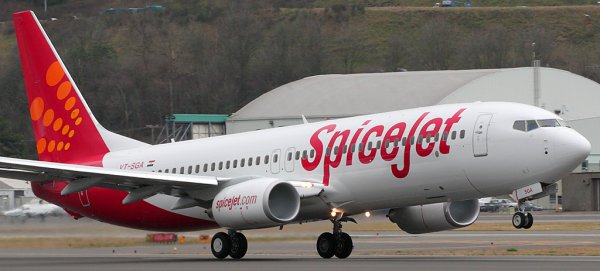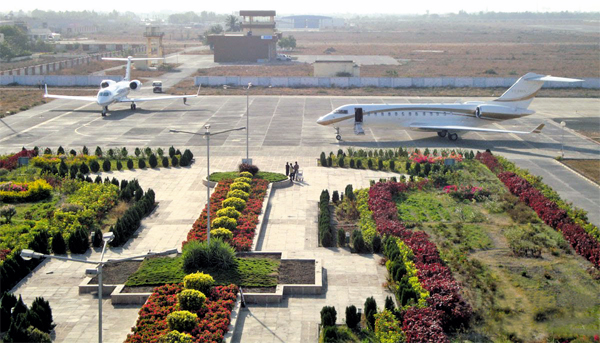|
Exactly a year ago, about 15 players had applied
for starting regional airlines. Only one –
Air Costa from Vijayawada – took to air,
while Air Pegasus from Bangalore announced end-2013
that it would soon commence operations. There
is no news with regard to the rest. Some of the
names that have been in the air include low cost
airlines SpiceJet and IndiGo, besides Air Dravida
from Chennai.
According to media reports in early 2013, IndiGo,
the country’s largest airline by market share,
is understood to be planning to set up a regional
airline for connecting small towns using 70-80
seater ATR aircraft. Economic Times said that
IndiGo promoter Rahul Bhatia met officials in
the civil aviation ministry recently and discussed
a plan to set up a subsidiary only to operate
on regional routes.
In 2011, SpiceJet announced that it would launch
a regional airline connecting smaller towns with
metro cities in South India shortly. The airline
announced its intent to tap the growing regional
market with an order for 15 Bombardier Q400 turboprop
aircraft — which can accommodate 70-80 people.
The northern part of the country is well connected
and the company had said it would focus in the
south, reaching destinations which are less than
two hours from Hyderabad. After these announcements,
there has been no activity whatsoever.
It remains to be seen whether these applicants
will make a fresh attempt, now that a new regional
policy has come into place.
The civil aviation ministry is clearer now about
the role of regional aviation and intends to promote
regional and remote-area connectivity.
$12 BILLION INVESTMENT
IN AIRPORTS
At the show, the Minister of Civil Aviation,
Ajit Singh emphatically stated that pan-India
air connectivity would get priority and accordingly
the Airports Authority of India (AAI) is developing
50 low-cost airports in remote and interior areas.
The government envisages an investment of $12.1
billion in the airports sector during the 12th
Plan period, of which $9.3 billion is expected
to come from the private sector for construction
of new airports, expansion and modernisation of
existing airports and development of low-cost
airports.

NEW POLICY
With a view to achieving better regulation of
air transport services and taking into account
the need for transport services of different regions
and remote areas, the Ministry has directed every
operator to provide a minimum of air transport
services to designated remote and strategic areas
as well as areas designated in the new regional
aviation policy.
The industry expected the government to do away
with the Route Disbursal Guidelines (RDG), instead
the government has offered a slew of incentives.
Earlier, the RDG made it mandatory for airlines
to deploy 10 per cent of their trunk-route capacity,
like Delhi-Mumbai on non-metro routes or Category
II routes, which are often financially unviable.
Apart from this, scheduled operators also had
to deploy at least 50 per cent of their trunk-route
capacity on so-called category III routes, smaller
towns and cities such as Coimbatore and Hubli.
The Airports Authority of India (AAI) has called
for a relook at the RDG as passenger and aircraft
traffic was heavily loaded towards 17 international
airports as compared to 55 domestic airports.
Domestic airports had less than 10 per cent passenger
traffic.
SIX PER CENT MANDATORY
As per the new policy, it is now mandatory for
all scheduled airlines to operate at least six
per cent of their total domestic operating capacity
to airports in remote or strategic areas. Areas/airports
where operations mandated are – North East
region with the exception of Guwahati and Bagdogra;
all airports in J&K except Jammu; Andaman
and Nicobar Islands and Lakshadweep.
It is also mandatory for airlines to operate
at least one per cent of their total operating
capacity on sectors/routes operated within the
above areas. The total operating capacity means
the number of seats operated by an airline in
all its sectors, multiplied by sector distance
in kilometres. The Ministry states that these
areas/airports would be reviewed from time to
time to ensure that the operators adhered to the
norms.

PAN-INDIA CONNECTIVITY
The list of airports identified for providing
concessions are – Cuddapah (Andhra Pradesh);
Akola, Gondia, Jalgaon, Nanded, Nashik and Sholapur
(Maharashtra); Keshod, Bhavnagar, Rajkot and Porbandar
(Gujarat); Cooch Behar and Hoogli (West Bengal);
Kota (Rajasthan); Shimla, Dharamshala, Bhuntar/Kulu
(Himachal Pradesh); Bilaspur (Chhatisgarh); Jabalpur
(Madhya Pradesh); Deoghar (Jharkand); Gaya (Bihar);
Jharsuguda (Odisha); Tuticorin (Tamilnadu); Ludhiana
(Punjab); Mysore, Hubli and Belgaum (Karnataka);
and Puducherry, all under the Airports Authority
of India (AAI).
The regional airports included are Sagar (Madhya
Pradesh); Bareilly and Meerut (Uttar Pradesh):
Karnal (Haryana); Diu and Jamshedpur.
The regional airports (civil enclaves) are Gwalior
(Madhya Pradesh); Pathankot and Bhatinda (Punjab);
Bikaner and Jaisalmer (Rajasthan); Jamnagar (Gujarat);
and Kanpur and Allahabad (Uttar Pradesh).
CONCESSIONS TO SPUR ACTIVITY
The Ministry has announced the following concessions
to any passenger or cargo aircraft which operate
to the above airports for an initial period of
three years. The concessions are: Exemption from
landing and parking charges; RNFC chargers; PSF;
Fuel throughput charges and any other charges
levied by AAI.
SELF-GROUND HANDLING
Another important concession that is being provided
to airlines/operators is self-ground handling
at these airports. The Civil Aviation Ministry
is requesting airports under the control of the
Ministry of Defence to provide similar concessions.
These concessions will be available to scheduled
and non-scheduled airlines/operators that operate
as per schedule for public. Other aircraft operators
will not be entitled to these concessions.
ROLE OF STATE GOVERNMENTS
As State Governments are important stakeholders
in improving air connectivity, the Ministry will
be asking them to provide support to the aviation
sector. The States will be asked to provide security
and fire-fighting services; reduced VAT on fuel
uplifted from within the State; infrastructure
for proper access to airports; waiver of duty
on electricity charges; waiver of municipal charges
such as property tax/house tax etc for five years;
and underwriting of seats.

AIR-CONNECTIVITY FUND
The policy also has suggested establishing an
air connectivity fund as a long term measure to
provide necessary financial support to promote
regional aviation. The size of the fund, tenure
and the institutionalised mechanism to administer
the fund is to be separately notified by the government.
For development of low cost airport and to improve
air connectivity to remote cities of the country,
Essential Air Services Fund (EASF) may be created
with the help of Central/State Governments and
Airport Operators. The fund can also be collected
from passengers who are flying on Category –
I and III routes. The fund so collected can be
used on routes which are commercially unviable
for 3 - 5 years till they reach a level of maturity.
The policy has been long overdue but one must
appreciate the fact that the Ministry had several
discussions with various stakeholders. Consultancy
firm KPMG had suggested that the government allow
‘no-frills’ airport model to lower the
fixed cost of airport development and to improve
the financial viability of Tier II and III airports.
The Airports Authority of India had pointed
out that development of new or sustaining the
existing small/remote airports was becoming increasingly
unviable as significant investment in creation
of new or improvement of the existing infrastructure
is required. It should be appreciated if such
capital expenditure is to be sustained it should
be adequately remunerated. Airports should make
reasonable returns not just to cover the cost
of capital for the investors/lenders but also
should allow the provision of high quality of
service to passengers and airline while also having
the funds available for investment in future growth.
In this context, in India most of the small
and remote airports are mostly unviable from revenue
point of view. The revenue generated out of operating
these airports will not be even sufficient to
meet the operational expenditure, let alone making
profits out of the business. Therefore, funding
to make such airports viable must include Government
grant for putting up infrastructure and State
Government assistance by sharing operational cost,
as they are the direct beneficiaries.
The Association of Private Airport Operators
(APAO) suggested that a Regional Scheduled Operator
Permit (RSOP) be created as to help small airports
and also operators. With the growing need for
air connectivity, it is essential to support and
encourage regional players to enter into the aviation
sector.
Although delayed, the government has started
making the moves for enhanced connectivity. It
is now for entrepreneurs to give them wings.
|